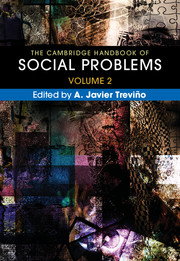Book contents
- The Cambridge Handbook of Social Problems
- The Cambridge Handbook of Social Problems
- Copyright page
- Contents
- About the Contributors
- Introduction
- Part I Problems Related to Health, Safety, and Security
- Part II Problems Related to Crime and Violence
- Chapter 12 The Problem of Crime
- Chapter 13 Corporate Malfeasance as a Social Problem
- Chapter 14 The Construction of School Bullying as a Social Problem
- Chapter 15 Rampage School Shootings
- Chapter 16 Understanding Sexual Violence: The Role of Causal and Precipitating Factors in Sexual Offending
- Chapter 17 Critical and Intersectional Understandings of Campus Sexual Assault as a Social Problem
- Chapter 18 Child Abuse and Neglect
- Chapter 19 Family Violence
- Chapter 20 Juvenile Violence
- Chapter 21 Gangs and Gang Violence
- Chapter 22 State Violence
- Chapter 23 Hate Crime
- Chapter 24 Police Brutality
- Chapter 25 Capital Punishment/Death Penalty
- Chapter 26 Wrongful Convictions: Comparative Perspectives
- Part III Problems of Global Impact
- Index
- References
Chapter 22 - State Violence
from Part II - Problems Related to Crime and Violence
Published online by Cambridge University Press: 16 March 2018
- The Cambridge Handbook of Social Problems
- The Cambridge Handbook of Social Problems
- Copyright page
- Contents
- About the Contributors
- Introduction
- Part I Problems Related to Health, Safety, and Security
- Part II Problems Related to Crime and Violence
- Chapter 12 The Problem of Crime
- Chapter 13 Corporate Malfeasance as a Social Problem
- Chapter 14 The Construction of School Bullying as a Social Problem
- Chapter 15 Rampage School Shootings
- Chapter 16 Understanding Sexual Violence: The Role of Causal and Precipitating Factors in Sexual Offending
- Chapter 17 Critical and Intersectional Understandings of Campus Sexual Assault as a Social Problem
- Chapter 18 Child Abuse and Neglect
- Chapter 19 Family Violence
- Chapter 20 Juvenile Violence
- Chapter 21 Gangs and Gang Violence
- Chapter 22 State Violence
- Chapter 23 Hate Crime
- Chapter 24 Police Brutality
- Chapter 25 Capital Punishment/Death Penalty
- Chapter 26 Wrongful Convictions: Comparative Perspectives
- Part III Problems of Global Impact
- Index
- References
Summary
Social scientists define state violence broadly, ranging from direct political violence and genocide to the redefinition of state violence as the neoliberal exit of the state from the provision of social services and the covert use of new technologies of citizen surveillance. State violence, and sometimes the state in and of itself, is clearly a social problem shaping not only the structure of governance but also citizenship and the quality of life of individuals and communities. This chapter provides a guide to the literature on state violence using the much studied case of Guatemala as a focal example. The chapter presents competing concepts on the nature of violence, analyzes the different forms of state violence (genocide, political violence, and juridical violence), and suggests emerging trends in the literature of state violence that lead us to consider structural inequalities, the changing nature of the state, and the incorporation of new technologies of violent governance.
- Type
- Chapter
- Information
- The Cambridge Handbook of Social Problems , pp. 381 - 398Publisher: Cambridge University PressPrint publication year: 2018
References
- 4
- Cited by



